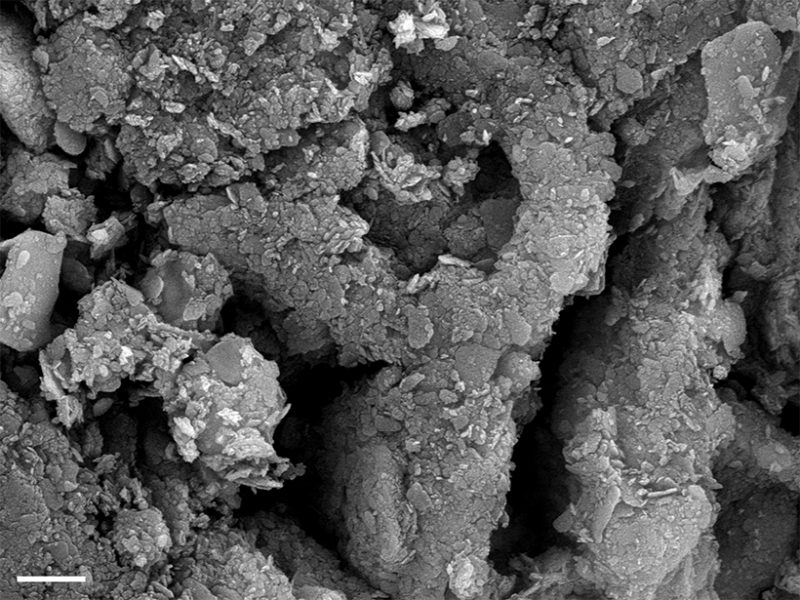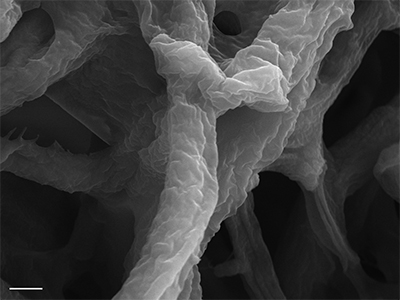Featured Stories, MIT, News | November 18, 2016
Replicating Ancient Fossilization
By Lauren Hinkel
About 555 million years ago during the Ediacaran period, delicate photosynthetic bacteria were seemingly immortalized in the geologic record—preserved exquisitely in layers of clay and silica. Outside of this era however, scientists rarely see fossilization of this caliber, particularly in marine environments, leaving researchers wondering what oceanic conditions in the Ediacaran made preservation of these fragile organisms possible. And further, since some of the world’s oldest animal fossils were also formed during the same time, understanding this process could help shine some light on how larger soft-tissue organisms were saved in the rock record too.
Now, work published in the journal Geology and led by Sharon Newman, a PhD candidate in MIT’s Bosak lab, may explain how this is possible. Newman studies historical microbe-mineral interactions and experimentally replicates these using present-day bacteria that were also prolific during the Ediacaran. “We basically try and fossilize modern communities,” to understand the mechanisms at play, said Newman.

Examining the Ediacaran
But before Newman and her team could begin their laboratory work, they needed to better understand potential reasons for the near-pristine fossilization seen in the Ediacaran. Through observations, scientists like Newman have found that bacterial fossils were coated in fine clays, indicating that this may be a key step facilitating preservation in the Ediacaran’s siliciclastic (silica-based, sedimentary) rocks. And when undisturbed, microbial colonies or “mats” can build up with silica and clays on the seafloor, forming large rocks with bacterial “textures” resembling thick wrinkled skin.
But after this period, aquatic conditions changed dramatically, decreasing the amount and quality of preservation. “There have been various theories in the literature [for this], some involving the proliferation of grazing and bioturbating organisms,” said Newman. Researchers think that after the Ediacaran, animals evolved to eat the marine bacterial mats before they could die and settle on the seafloor. Another possibility is a steep decline in the amount of silica and clay suspended in the oceans, possibly thanks to the evolution of silica-dependent organisms like diatoms and sponges.
A Closer Look
Newman and her colleagues took to investigating the significance of oceanic silica and suspended clay in the fossilization process. To do this, they grew modern cyanobacteria populations on beach and siliciclastic sand in seawater that chemically resembled Ediacaran oceans. First, Newman experimented with different levels of dissolved silica, as concentrations of the mineral were found to have been higher in the Ediacaran’s mineral-rich seas than today. In most of the samples with high silica, the cyanobacteria and their filaments developed “a beautiful coating,” of clay, suggesting that this might be a precursor or the beginning of fossilization.
But how were the clays coming to encase the bacteria, and to what extent does particle size and concentration of clay in suspension affect microbe coating?
Next, the group asked themselves, “Are these bacteria precipitating clay minerals from ions in solution or are they trapping clays from the sand [which is made of larger quartz grains, clays and miccas]?” The researchers considered clay to be “trapped” by a bacterium if a suspended particle floated through the water and became stuck to the organism or its filaments, eventually building up layers of clay.

They found that when the naturally sticky surface of the bacteria encountered large clay particles in high concentrations, the minerals covered the microbes. The bacteria were capable of trapping clays from artificial ancient oceans.
Addressing the question of the precipitation mechanism required some ingenuity on the part of the research group. Using dialysis bags, the scientists separated the cyanobacteria from “Ediacaran” water, containing the dissolved clay ions. In order for clay to coat the microbes this way, the small ions must pass through the bag into ocean water without clay and build up on the bacteria over time. After waiting about a month, Newman and her colleagues saw that a tiny bit of clay was accumulated on the bacteria.
Despite the fact that both techniques produced “coating” results, one appeared to be dominant. “We found that the majority of the coating was due to trapping, but some of it, on a longer-term was also due to precipitation. And so, in the end you have this beautiful coating due to the synergistic effects of both trapping and precipitation,” explained Newman.
While the theory of silica’s importance in bacterial preservation in the Ediacaran isn’t new, “to my knowledge, there haven’t been many studies that experimentally looked at silica and how silica levels would affect fossilization,” said Newman.
The team’s work has implications for the fossilization of other Ediacaran species. In the ocean, when soft-tissue organisms die, they sink to the seabed and begin decaying. But some scientists think that the presence of prolific, clay-coated microbial mats could be a game-changer on the decomposition playing field—“blanketing” the newly deceased animal and creating a barrier between it and the elements. Each layer would help to ensconce and protect the tissues as they fossilized.
Building on this recent study, Newman’s current work is looking into exactly this question. “I’m doing a whole series of experiments growing microbial mats over scallops and shrimp and even some bloodworms, and I’m trying to see how different organisms are affected by the presence of these mats and clays.”


 Simons Foundation Awards EAPS Investigators
Simons Foundation Awards EAPS Investigators


